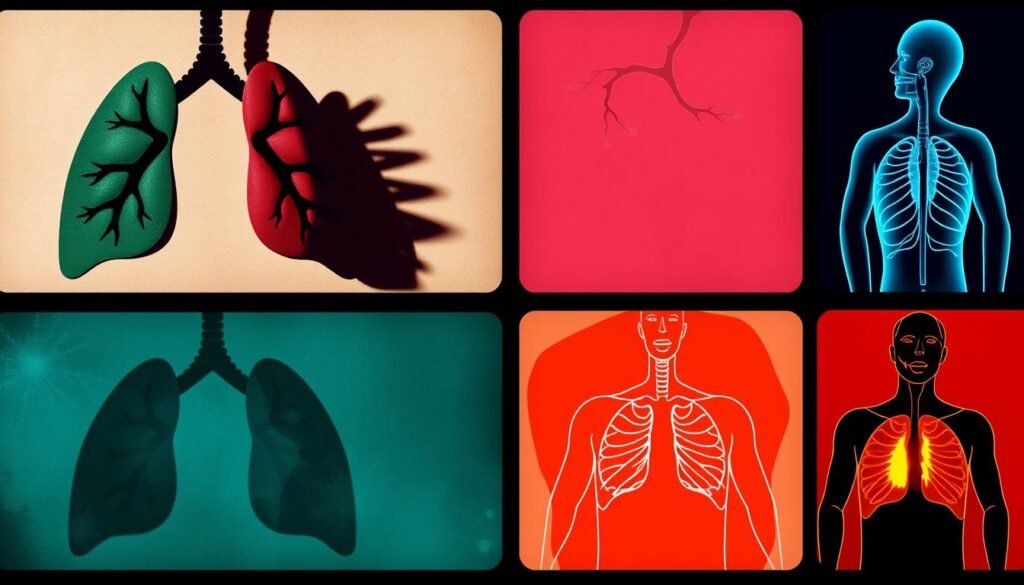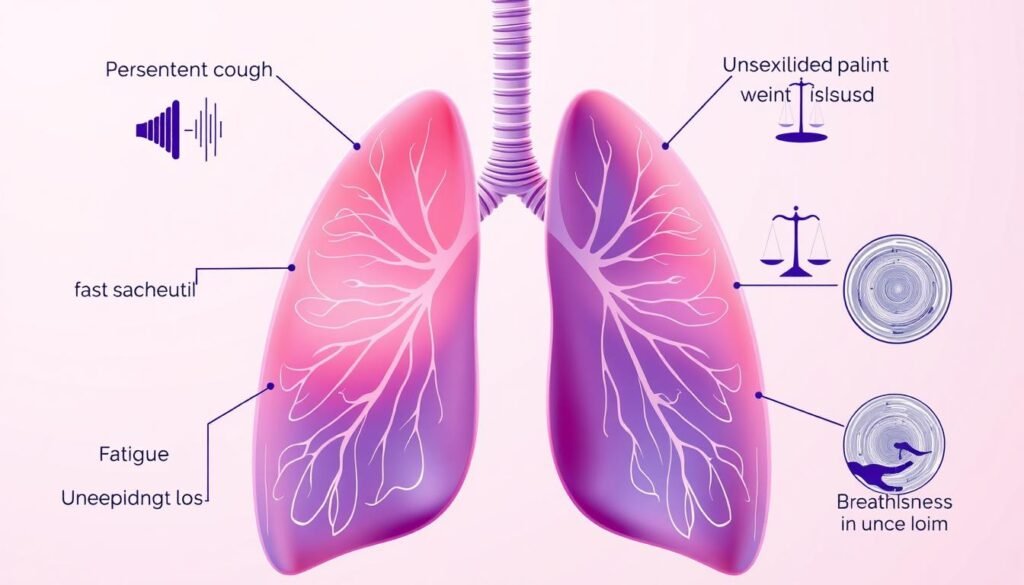Lung cancer is the second most common cancer in the United States. It impacts thousands every year. However, many are not aware of the early signs. This silent killer often does not show symptoms until it’s late. A *persistent cough* lasting over eight weeks may be a warning. Symptoms like chest pain and struggling to breathe are also key indicators. Knowing these can greatly improve chances of successful treatment.
Key Takeaways
- Lung cancer may not show symptoms until it progresses to an advanced stage.
- A chronic cough is a common early warning sign of lung cancer.
- Chest pain and breathlessness can also indicate lung cancer’s presence.
- Awareness of lung cancer symptoms can lead to timely diagnosis and improved outcomes.
- Regular health check-ups are essential, especially for those at higher risk.
Understanding Lung Cancer
Lung cancer is a major health issue worldwide, leading to the most cancer-related deaths. It starts in the lung cells and can grow for years without symptoms. This makes it crucial to understand this disease. For those who want to learn, understanding lung cancer means knowing its types, how it grows, and what increases risk.
There are two main kinds of lung cancer: non-small cell (NSCLC) and small cell (SCLC). NSCLC is more common, making up about 85% of cases. NSCLC has three subtypes:
- Adenocarcinoma
- Squamous cell carcinoma
- Large cell carcinoma
Adenocarcinoma is more often found in women, especially those who’ve never smoked. SCLC is linked to smoking and grows and spreads quickly. Symptoms of SCLC can be severe, like bone pain and confusion.
Knowing how lung cancer grows is key for early discovery. Early-stage lung cancer usually has little to no symptoms. The disease is often advanced by the time symptoms show. Risk factors for lung cancer include smoking a lot, being around secondhand smoke, and having a family history of the disease.
| Type of Lung Cancer | Characteristics | Prevalence | Associated Risk Factors |
|---|---|---|---|
| Non-small cell lung cancer (NSCLC) | Slower growth, more common, three subtypes | 85% of cases | Smoking, family history |
| Small cell lung cancer (SCLC) | Rapid growth, aggressive spread | 15% of cases | Heavy smoking |
Keeping these factors in mind can lead to better health results. Being aware of lung cancer’s characteristics and symptoms helps people get medical help sooner. This is vital for successful treatment.
Importance of Early Detection
Finding lung cancer early is crucial in the battle against this disease. It’s the second most common cancer and the top cancer killer in the U.S. Most lung cancer finds are made too late, making treatment hard. But, early screening can spot tumors early, boosting the chances of recovery.
Low-dose CT scans are a key tool for early detection in those at high risk. The American Cancer Society advises yearly scans for 50 to 80-year-olds with a heavy smoking past. While there’s a bit of radiation, it’s better at finding cancer early than old chest x-rays, which don’t really help survival rates.
Early detection needs to be a priority, including knowing lung cancer risks. When people get screened and know the signs, we can save more lives. Right now, the five-year survival is about 18%. But finding cancer early can jump those chances up. Sadly, only 6% who could get screened do take this vital step.
In short, regular lung cancer screening and knowing how to spot it early are key to better health. We need to push for frequent checks for those at risk. This way, we can fight lung cancer’s heavy toll on lives.
Common Early Warning Signs of Lung Cancer
Knowing the early signs of lung cancer is very important. Some signs might not seem obvious but they’re key for health. Catching these early can make a big difference in treatment success.
Persistent Cough
If you’re coughing for more than two weeks, it’s a warning sign. This could show a deeper issue, like lung cancer. If your cough changes or gets worse, see a doctor quickly.
Also, if your cough gets more frequent or comes with strange mucus, get it checked. This needs a doctor’s opinion.
Coughing Up Blood
Coughing up blood is a serious warning sign. It often means something major. If you see blood or rust-color in your cough, get medical help right away.
Chest Pain
Chest pain is a serious symptom that could point to lung cancer. If pain gets worse when you breathe deeply, cough, or laugh, it’s time to see a doctor. A quick check-up for chest pain is very important.
| Symptom | Description |
|---|---|
| Persistent Cough | Cough lasting more than two weeks; may include changes or abnormalities. |
| Coughing Up Blood | Presence of blood in sputum; requires immediate medical consultation. |
| Chest Pain | Discomfort in the chest that worsens with breathing or coughing. |
Additional Lung Cancer Symptoms
Spotting lung cancer symptoms early can greatly help in treatment. There are more symptoms than many know, like breathlessness, hoarseness, extreme tiredness, and losing weight without trying. Knowing these signs is critical for your health and getting help early.
Breathlessness
Feeling short of breath might mean lung cancer, especially if it gets worse or starts suddenly. It can happen when the lungs are blocked or filled with fluid. Pay attention if you’re short of breath more than usual, as it might need a closer look.
Hoarseness
If your voice is hoarse a lot, it could be lung cancer affecting nerves that move vocal cords. A change in how your voice sounds could mean something serious that needs checking out. Getting help early for hoarseness can prevent more problems from lung cancer.
Fatigue
Feeling very tired all the time can also be a sign of lung cancer. This kind of tiredness doesn’t get better with rest and can change your daily activities. If you’re always tired for no clear reason, it’s important to understand it might be related to lung cancer.
Unexplained Weight Loss
Losing a lot of weight suddenly, more than 10 pounds, without dieting or more exercise can warn of lung cancer. This might happen because your body acts differently or you’re not as hungry because of the cancer. It’s crucial to talk to a doctor about such weight loss to avoid missing serious health issues.

Lung Cancer Risk Factors
Many things can increase your risk of lung cancer. Smoking is the biggest cause, linked to about 80% of deaths from this disease. The more you smoke, the higher your risk. Secondhand smoke is also dangerous, being the third leading cause of lung cancer in the U.S. It affects people who are often around those who smoke.
Radon gas is the second biggest cause of lung cancer here, especially concerning for those who don’t smoke. People exposed to asbestos at work are in extra danger. This risk gets even worse if they also smoke, making a dangerous mix.
Pollution outside and having a family history of lung cancer also up your risk. Outdoor air pollution contributes to 1% to 2% of lung cancer deaths. If lung cancer runs in your family, your own risk goes up, especially if your relatives were diagnosed young. It increases even more if several close family members have had it.
Smoking marijuana and vaping can be risky too. They bring health issues like those from smoking tobacco. The FDA says e-cigarettes are tobacco products. More studies are being done to see if they directly cause lung cancer.
| Risk Factor | Impact on Lung Cancer Risk |
|---|---|
| Smoking | ~80% of lung cancer deaths |
| Secondhand Smoke | Third most common cause |
| Radon Exposure | Second leading cause, especially for non-smokers |
| Asbestos Exposure | Significantly increases risk, especially with smoking |
| Outdoor Air Pollution | 1%-2% of lung cancer deaths |
| Family History | Doubles risk with young relatives diagnosed |
| Marijuana Smoking | Contains tar and cancer-causing substances |
| E-cigarettes | Potential lung damage; unclear link to cancer |
When to See a Doctor
Knowing when to get a medical consultation is key for dealing with lung cancer symptoms and other health concerns. Don’t overlook ongoing symptoms like a lasting cough or unknown weight loss. A study in 2018 found that 34.1% of lung cancer patients had lost weight before being diagnosed. This shows why it’s crucial to get medical advice early.
Smokers face a much higher risk of developing lung cancer. According to the CDC, smoking causes up to 90% of lung cancer deaths. If you’ve smoked a lot, talk to your doctor about getting screened. The U.S. Preventive Services Task Force suggests yearly screenings for those 50 to 80 years old who have smoked for 20 pack-years or more.
It’s important to see a doctor right away if you have certain symptoms:
- Persistent cough that gets worse
- Coughing up blood or rust-colored spit
- Chest pain when breathing deeply
- Unexplained weight loss
- Shortness of breath
These symptoms could point to serious issues needing quick action. Finding problems early can lead to better treatment options and outcomes.

Early Warning Signs of Lung Cancer
Lung cancer shows different early signs that are important to spot right away. Catching these signs early is key to getting help quickly. Some main signs to look out for are changes in how hungry you feel, getting sick often, and making a whistling sound when you breathe.
Changes in Appetite
Not feeling like eating much can be a big warning sign. Maybe food doesn’t taste right, or you’re just not hungry. This could mean lung cancer is affecting your body. It’s critical not to ignore these changes, as they might help spot the disease early.
Recurring Infections
Getting sick a lot, like catching bronchitis or pneumonia over and over, can be a clue. It might mean lung cancer is making it hard for your body to fight off infections. This weak lung function hints that it’s time to check things out further.
Wheezing
Wheezing is when you hear a whistling sound as you breathe in and out. It can mean your airways are blocked, possibly by tumors. Spotting wheezing early can lead to faster diagnosis and better chances against lung cancer.
Symptoms of Advanced Lung Cancer
As lung cancer gets worse, its symptoms start to change. Knowing these advanced symptoms is key for getting help in time. People might notice different signs that the cancer could be spreading:
- Bone pain, when cancer moves into the bones.
- Severe fatigue, which makes daily life hard.
- Headaches, showing changes in the nervous system, perhaps because the cancer has reached the brain.
- Jaundice, which turns the skin and eyes yellow, showing liver involvement.
- Swelling of lymph nodes, showing the cancer is moving, which means it’s getting worse.
It’s critical to know when early signs of lung cancer become severe. Signals like a steady cough and losing weight without trying can turn into more serious issues. This shows that the lung cancer is getting to a late stage. As it does, treatment might not work as well.
If you or someone you know has these worrying signs, seeing a doctor quickly is very important. A fast response can lead to an earlier diagnosis. This can make treatments work better and improve chances of recovery. For more on early warnings of lung cancer, check this resource.

| Symptom | Description |
|---|---|
| Bone Pain | Discomfort or pain in the bones due to metastasis |
| Fatigue | Persistent tiredness affecting everyday activities |
| Headaches | Frequent headaches indicative of potential brain involvement |
| Jaundice | Skin and eye yellowing due to liver effects |
| Lymph Node Swelling | Enlarged lymph nodes as cancer spreads |
Potential Complications from Lung Cancer
Lung cancer can cause many complications that hurt a patient’s life quality. One major issue is severe shortness of breath. This happens when cancer blocks major airways or causes fluid to build up around the lungs. This condition is called pleural effusion.
To fix this, treatment may be needed to help with symptoms and make breathing easier. Besides difficulty breathing, patients might cough up blood. This is due to cancer reaching the airways, which is very troubling. Handling these lung cancer complications is key.
Doctors often team up to offer thorough care. This care might include steps to make breathing less difficult. Knowing all about lung cancer’s challenges is vital. Catching it early and starting treatment soon, like the advice in this resource, is important. Staying alert to any breathing problems and getting regular checks is essential for good health.
Conclusion
Lung cancer awareness is key for better survival rates and treatment results. Recognizing signs like a persistent cough or weight loss helps with early detection. It’s crucial for people to know their bodies and see doctors quickly if something seems off. This helps catch issues early, which is important for lung health.
Also, knowing lung cancer risks and complications makes us more careful about our lung health. Lung cancer is the top cause of cancer death in the U.S. Making sure people know about it through education is critical. Health checks are especially important for high-risk groups. For example, veterans aged 50-80 who have smoked should get scans like LDCT.
We should all encourage getting checked out for any odd symptoms, not just those that seem like lung cancer. Acting early helps keep our lungs healthier. It means better chances for effective treatment. Awareness, learning, and quick action are key in battling lung cancer.